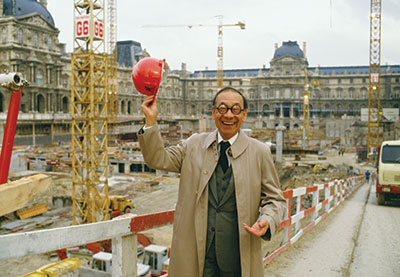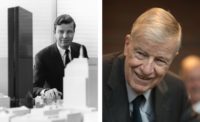I rejoice, even at this moment of sadness, in a close fellowship that immeasurably enriched my life across seven decades. A few random thoughts come to mind as I remember my mentor, colleague, and friend.
Complementing and enhancing his exceptional gifts as a designer, I.M. Pei displayed an astonishing capacity to absorb Western cultures while remaining deeply connected to that of his native land. This capacity, combined with his innate curiosity and unfailing charm, transformed even the most mundane conversation into an often wide-ranging exploration not just of architecture but of the arts broadly interpreted—including even the culinary and the oenological—and of the diverse cultures from which they spring.

It should not be forgotten—for this was indeed a portent of things to come—that Pei’s 1946 thesis project in Walter Gropius’s master class at Harvard was a direct if subtle challenge to the radically ahistorical pedagogy of the Modern movement as practiced by the founder of the Bauhaus. Pei proposed that a museum of Chinese art in Shanghai should incorporate references to the very ancient culture therein to be celebrated, and that effective instruments for this were to be found not only in built form but also in nature. To each of these propositions, a skeptical Gropius replied, “Prove it!” and in the end acknowledged that Pei had done so.
Pei’s 12-year stint (1948–60) in the employ of the developer William Zeckendorf Sr. has sometimes been portrayed as a wasteful if not counterproductive episode, delaying his pursuit of those cultural building projects that most attracted him and that would later make him world-famous. While it is true that Pei himself would have preferred that this episode end sooner, a review of built works completed during the 1950s shows conclusively that these projects laid the essential groundwork—technical, managerial, and conceptual—for his subsequent practice. Indeed, the bold adventures in cast-in-place concrete that propelled him to the forefront of his profession in the decade of the ’60s—the National Center for Atmospheric Research in Boulder, Colorado; the art museums in Des Moines and in Syracuse, New York—would have been neither conceivable nor achievable without the technical expertise and staff resources that had been created during the previous decade in response to the challenge of designing budget-constrained middle-income housing. And the passage of time has confirmed that these early works were no throwaway projects: Kips Bay Plaza in New York and Society Hill Towers in Philadelphia, for example, are today widely recognized as significant landmarks in postwar American architecture.

As the foregoing suggests, Pei’s creativity and resourcefulness were evidenced not only in his built works but also in the apparatus undergirding his practice, wherein he assembled an exceptionally capable team of dedicated colleagues whose diverse skills were integrated and invigorated by his leadership. In offering a toast at a luncheon marking Pei’s 50th birthday on April 26, 1967, I reflected on the source of this distinctive esprit de corps: “There is a proverb, I.M., that has come down to us from the antiquity of your homeland and that seems to me pertinent to this occasion. A wise man said, ‘Excellence does not remain alone; it is sure to attract neighbors.’ Your friends around the table here can surely understand the full meaning of this truth, because we have all, over the years of our association with you, enjoyed the splendid adventure of being neighbors to excellence. Of course, it must be said of you now, as the superbly accomplished practitioner of a universal art, that the world is your neighbor, and that we who salute you here are but surrogates for a vast throng of friends and admirers whose good wishes are always with you. Nonetheless, because we were among your earliest neighbors, and more important because we have for you that special affection which is the reward for having worked together toward high goals, we claim the privilege now of drinking a toast to the continued health and prosperity of our mutual friend, Mr. I.M. Pei.”






